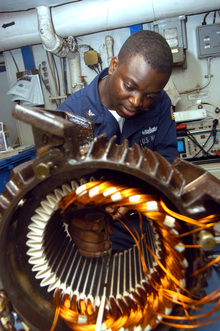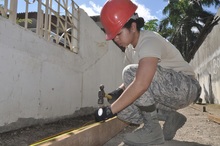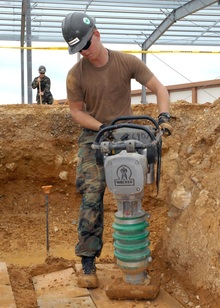MainBoss: How you use it, day to day
How does MainBoss make your life easier? The best way to get the picture is to look at work flow: the process of doing a job from start to finish.
We'll look at two types of job:
- Corrective maintenance: Fixing a problem that someone reports
- Planned maintenance (also called preventive maintenance): Making an inspection, or performing a standard task (lubrication, changing filters, replacing worn parts, etc.) according to some schedule
Corrective Maintenance
All maintenance departments serve "clients": people outside the maintenance department itself. Maybe your clients are other people in your organization; maybe your clients are tenants or customers whose property and equipment you maintain. Either way, a major part of your job is responding to problems that your clients report.
Step 1: Receiving Work Requests
So how can your clients report problems? MainBoss gives you options:
- Clients can report problems in traditional ways such as phone calls to maintenance personnel (e.g. a help desk or the maintenance department secretary)
- Clients can report problems by email: The MainBoss Service module lets authorized users submit problem reports by email. The resulting work requests are automatically placed in MainBoss's database.
- Clients can report problems using the web: MainBoss's Web Requests module lets authorized users go to a web page where they can easily create problem reports. Again, the resulting work requests are automatically placed in MainBoss's database.
Submitting work requests by email or the web isn't just convenient for your clients—it makes work easier for the maintenance department. MainBoss has facilities that let you turn a work request directly into a work order. You start with the original request and just add whatever details are needed (e.g. assigning one or more workers. If necessary, you can add any details that the workers might need in order to get the job done. Very quickly, you turn the request into a complete work order ready to be done.
There's another convenience to receiving work requests by email or from the web#8212;MainBoss deals with your clients for you. MainBoss automatically sends email to the client, saying that the request has been received. If you want, MainBoss can also email automatic updates to the client when the job is finished, and at various points in between. Clients stay happy because they're kept "in the loop"...and you'll be happy too, because it happens automatically, without any need for maintenance personnel to make a special effort.
Just do your job. MainBoss will worry about handholding the clients.
Step 2: Doing the Work
Once you've received a request and written up a work order, what do you do?
You can print off the work order if you want...but MainBoss gives you the option of going paperless. This can be a huge time-saver; one maintenance manager recently told us that he loses an hour a day just printing off work orders, sorting them out, putting them in workers' mailboxes, and so on—paper-pushing that wastes time, and also paper. (These days, when companies are trying to go "green", it doesn't hurt to tell your boss that MainBoss can reduce your paper use.)
If you license MainBoss's Web Access module, workers can access their assigned work orders online, using either a normal computer or a mobile device (e.g. an iPhone or BlackBerry). Not only can your workers read their work orders, they can add comments, record the time they spent on the job, and the materials they used. They can even close the work order when the job is finished.
By the way, MainBoss has many many features to make a worker's job easier. As just one example, MainBoss makes it easy to keep track of your inventory of spare parts: which part is in which storeroom. When you write up a work order, you can check which storerooms contain any parts the job needs. You can then tell the worker where to get those parts; workers don't have to wander from storeroom to storeroom trying to find the parts they want. The job gets done faster with less aggravation for everyone.
Planned Maintenance
In an ideal world, nothing would ever break. That ideal will never materialize, but a good program of planned maintenance can prevent many problems and detect many others before anything goes seriously wrong. Instead of constantly dealing with emergencies, much of your work becomes predictable and subject to sensible schedules. Things run smoothly for you and your clients, saving everyone money, time, and aggravation.
In MainBoss, here's how planned maintenance (PM) works in practice.
- You start by describing what should be done in a PM job. The job might involve checking for potential problems, replacing old parts with new ones, lubricating and/or cleaning machinery, and so on. Note that planned maintenance applies to more than just "equipment"; it also includes things like walk-around inspections of your premises.
- For each unit (e.g. a location or piece of equipment), you set up a schedule for doing the PM job. For example, for each company car, you set up a schedule for doing standard vehicle maintenance. Schedules can be based on date (e.g. every three months), on meter reading (e.g. every 3000 miles), or both.
-
On a regular basis (e.g. every week), you ask MainBoss to check
which PM jobs are about to come due.
MainBoss does so, and creates work orders for doing those jobs.
For example, if it's time to do an oil change on a car, MainBoss
creates a work order for such an oil change.
You have the choice of having MainBoss set up the work order in full detail—who'll do the job, what parts are needed, and so on—or you can have MainBoss write up the basics, and then you decide on details on a case-by-case basis. For example, consider oil changes a car: you might want to have the same mechanic do the oil change every time, or you might simply give the job to whichever mechanic is available. It's up to you how much you let MainBoss generate automatically and how much you do yourself.




